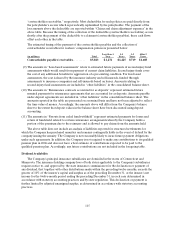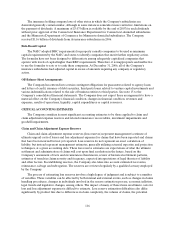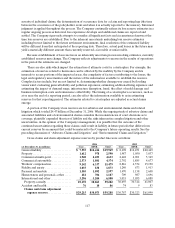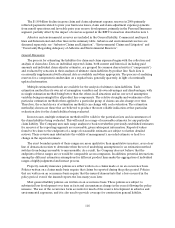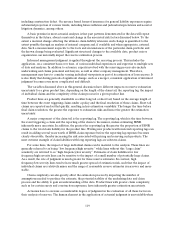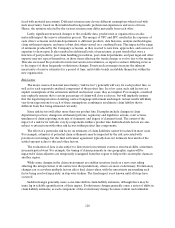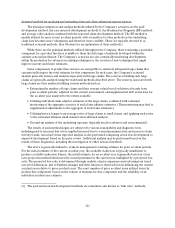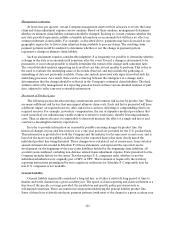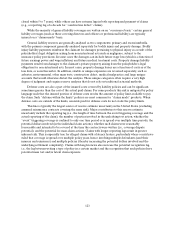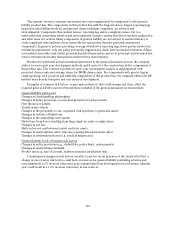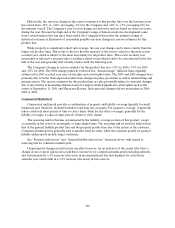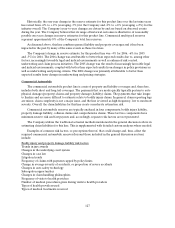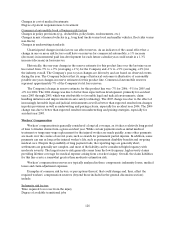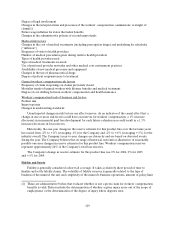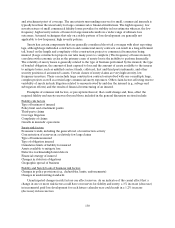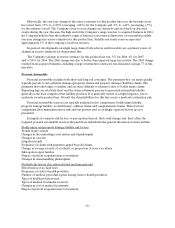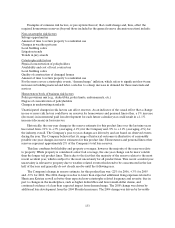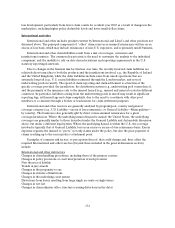Travelers 2006 Annual Report Download - page 137
Download and view the complete annual report
Please find page 137 of the 2006 Travelers annual report below. You can navigate through the pages in the report by either clicking on the pages listed below, or by using the keyword search tool below to find specific information within the annual report.
125
The Company’s change in reserve estimate for this product line, excluding estimated asbestos and
environmental amounts, was +2% for 2006, +4% for 2005 and +10% for 2004. The 2006 change largely
resulted from directors andofficers anderrors and omissions adjustments due to worse than expected
large loss activity and additional information from detailed claim reviews, primarily associated with
accident years 2002 and2003. The 2005 change was the net result of numerous adjustments for various
components with no individual item being a primary driver. The 2004 change was principally due to the
construction defect and construction wrap-up reserving actions discussed on page 76 of this narrative.
Property
Property is generally considered a short tail line with a simpler and faster claim reporting and
adjustment process than liability coverages, and less uncertainty in the reserve settingprocess (except for
more complex business interruption claims). It is generally viewed as a moderate frequency, low to
moderate severity line, except for catastrophes and coverage related to large properties. The claim
reporting and settlement process for property coverage claim reserves is generally restricted to the insured
and the insurer. Overall, the claim liabilities for this line create a low estimation risk, except possibly for
catastrophes and business interruption claims.
Property reserves are typically analyzed in two components, one for catastrophic or other large single
events, and another for all other events. Examples of common risk factors, or perceptions thereof, that
could change and, thus, affect the required property reserves (beyond those included in the general
discussion section) include:
Property risk factors
Physical concentration of policyholders
Availability and cost of local contractors
For the more severe catastrophic events, “demand surge” inflation, which refers to significant short-term
increases in building material and labor costs due to a sharp increase in demand for those materials and
services
Local building codes
Amount of time to return property to full usage (for business interruption claims)
Court interpretation of policy provisions (such as occurrence definition, or wind versus flooding)
Lags in reporting claims (e.g., winter damage to summer homes, hidden damage after an earthquake)
Court or legislative changes to the statute of limitations
Property book of business risk factors
Policy provisions mix (e.g.,deductibles, policy limits, endorsements)
Changes in underwriting standards
Unanticipated changes in risk factors can affect reserves. As an indicator of the causal effect that a
change in one or more risk factors could have on reserves for property, a 1% increase (decrease) in
incremental paid loss development for each future calendar year could result in a 1.1% increase (decrease)
in loss reserves.
Historically, the one-year change in the reserve estimate for this product line, excluding estimated
asbestos and environmental amounts, over the last nine years has varied from -3% to +14%
(averaging +5%) for the Company and -4% to +7% (averaging +1%) for the industry overall. The
Company’s year-to-year changes are driven by and are based on observed events during the year. Because
the highend of the Company’s range of historical adverse development came from certain business that
hassince been exited, the Company believes that the industry’s range of historical outcomes is illustrative
of reasonably possible one-year changes in reserveestimates for this product line. General liability reserves
(excluding asbestos and environmental) represent approximately 26% of the Company’s total loss reserves.


